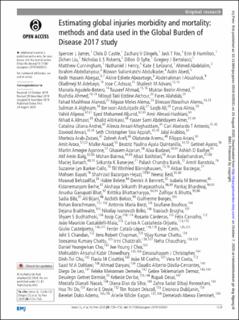| dc.description.abstract | Background While there is a long history of measuring death and disability from injuries, modern research methods must account for the wide spectrum of disability that can occur in an injury, and must provide estimates with sufficient demographic, geographical and temporal detail to be useful for policy makers. The Global Burden of Disease (GBD) 2017 study used methods to provide highly detailed estimates of global injury burden that meet these criteria.
Methods In this study, we report and discuss the methods used in GBD 2017 for injury morbidity and mortality burden estimation. In summary, these methods included estimating cause-specific mortality for every cause of injury, and then estimating incidence for every cause of injury. Non-fatal disability for each cause is then calculated based on the probabilities of suffering from different types of bodily injury experienced.
Results GBD 2017 produced morbidity and mortality estimates for 38 causes of injury. Estimates were produced in terms of incidence, prevalence, years lived with disability, cause-specific mortality, years of life lost and disability-adjusted life-years for a 28-year period for 22 age groups, 195 countries and both sexes.
Conclusions GBD 2017 demonstrated a complex and sophisticated series of analytical steps using the largest known database of morbidity and mortality data on injuries. GBD 2017 results should be used to help inform injury prevention policy making and resource allocation. We also identify important avenues for improving injury burden estimation in the future. | en_US |
| dc.description.sponsorship | Seyed Aljunid acknowledges the Department of Health Policy and Management, Faculty of Public Health, Kuwait University and International Centre for Casemix and Clinical Coding, Faculty of Medicine, National University of Malaysia for the approval and support to participate in this research project. Alaa Badawi acknowledges support by the Public Health Agency of Canada. Till Bärnighausen acknowledges support by the Alexander von Humboldt Foundation through the Alexander von Humboldt Professor award, funded by the German Federal Ministry of Education and Research. Traolach Brugha received support from NatCen Social Research (http://natcen.ac.uk/) via NHS Digital and Department of Health and Social Care London, for the Adult Psychiatric Morbidity Survey (APMS) programme. Felix Carvalho received support from UID/MULTI/04378/2019 with funding from FCT/MCTES through national funds. Vera M Costa acknowledges support from grant (SFRH/BHD/110001/2015), received by Portuguese national funds through Fundação para a Ciência e Tecnologia (FCT), IP, under the Norma Transitória DL57/2016/CP1334/CT0006. Kebede Deribe is supported by a grant from the Wellcome Trust [grant number 201900] as part of his International Intermediate Fellowship. Tim Driscoll acknowledges that work on occupational risk factors was partially supported by funds from the World Health Organization. Eduarda Fernandes acknowledges support from UID/QUI/50006/2019 with funding from FCT/MCTES through national funds. Yuming Guo acknowledges support from Career Development Fellowships of the Australian National Health and Medical Research Council (numbers APP1107107 and APP1163693). Sheikh Mohammed Shariful Islam is funded by a Fellowship from National Heart Foundation of Australia and Institute for Physical Activity and Nutrition, Deakin University. Mihajlo Jakovljevic acknowledges support by the Ministry of Education Science and Technological Development of the Republic of Serbia through the Grant number OI175014; publication of results was not contingent upon Ministry's censorship or approval. Sudha Jayaraman acknowledges support from: NIH R21: 1R21TW010439-01A1 (PI); Rotary Foundation Global Grant #GG1749568 (PI); NIH P20: 1P20CA210284-01A1 (Co-PI) and DOD grant W81XWH-16-2-0040 (Co-I), during the period of this study. Yun Jin Kim acknowledges support from a grant from the Research Management Centre, Xiamen University Malaysia [grant number: XMUMRF/2018-C2/ITCM/0001]. Kewal Krishan is supported by UGC Centre of Advanced Study (CAS II) awarded to the Department of Anthropology, Panjab University, Chandigarh, India. Mansai Kumar acknowledges support from FIC/ NIH K43 1K43MH114320-01. Amanda Mason-Jones acknowledges support by the University of York. Mariam Molokhia is supported by the National Institute for Health Research Biomedical Research Center at Guy’s and St Thomas’s National Health Service Foundation Trust and King’s College London. Ilais Moreno Velasquez is supported by the Sistema Nacional de Investigación (SNI, Senacyt, Panama). Mukhammad David Naimzada acknowledges support from Government of the Russian Federation (Agreement No – 075-02-2019-967). Duduzile Ndwandwe acknowledges support from Cochrane South Africa, South African Medical Research Council. Stanislav S. Otstavnov acknowledges the support from the Government of the Russian Federation (Agreement No – 075-02-2019-967). Ashish Pathak acknowledges support from Indian Council of Medical Research (ICMR), New Delhi, India (Grant number 2013-1253). Michael R Phillips acknowledges support in part by a grant from the National Natural Science Foundation of China (No.81761128031). Abdallah M. Samy received a fellowship from the Egyptian Fulbright Mission Program. Milena Santric Milicevic acknowledges the support from the Ministry of Education, Science and Technological Development, Republic of Serbia (Contract No. 175087). Seyedmojtaba Seyedmousavi was supported by the Intramural Research Program of the National Institutes of Health, Clinical Center, Department of Laboratory Medicine, Bethesda, MD, USA. Rafael Tabarés-Seisdedos was supported in part by the national grant PI17/00719 from ISCIII-FEDER. Sojib Bin Zaman acknowledges support from an "Australian Government Research Training Program (RTP) Scholarship.” | en_US |

